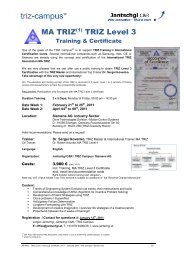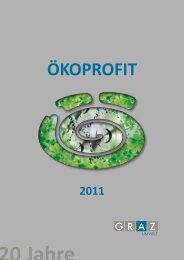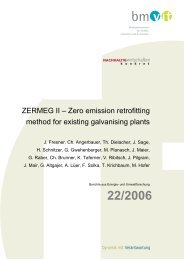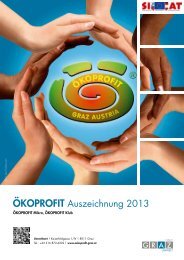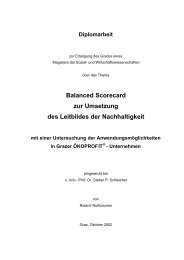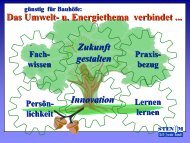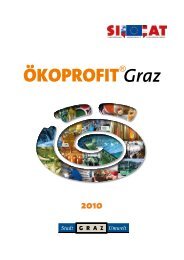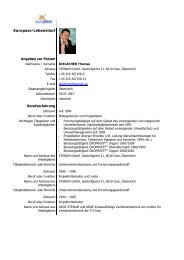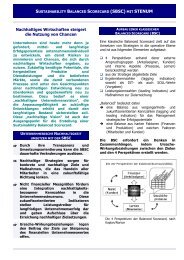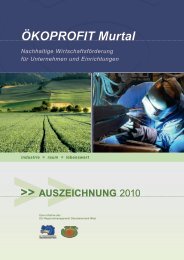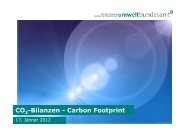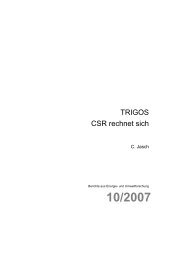Promoting Resource Efficiency in Small & Medium size ... - UNEP
Promoting Resource Efficiency in Small & Medium size ... - UNEP
Promoting Resource Efficiency in Small & Medium size ... - UNEP
Create successful ePaper yourself
Turn your PDF publications into a flip-book with our unique Google optimized e-Paper software.
Detailed assessment: Waste m<strong>in</strong>imisation<br />
7.1 WHAT:<br />
Waste m<strong>in</strong>imisation for SMEs<br />
7.1.1 General def<strong>in</strong>ition 59<br />
Waste is def<strong>in</strong>ed as a non-product output with a negative or zero<br />
market value. Waste can be solid, liquid or have a paste-like<br />
consistency. Water and air-pollut<strong>in</strong>g emissions – although they are<br />
non-product output – are not regarded as waste. If the value of the<br />
waste fluctuates accord<strong>in</strong>g to market conditions, accumulated net<br />
costs/revenues dur<strong>in</strong>g the report<strong>in</strong>g period are used to determ<strong>in</strong>e<br />
the market value.<br />
7.1.2 Def<strong>in</strong>itions based on the quality of waste 60<br />
Waste is divided <strong>in</strong>to the follow<strong>in</strong>g sub-categories accord<strong>in</strong>g to<br />
its quality:<br />
• M<strong>in</strong>eral<br />
M<strong>in</strong>eral waste is an <strong>in</strong>ert m<strong>in</strong>eral, which is <strong>in</strong>soluble and will<br />
not decompose. M<strong>in</strong>eral quality waste is safe by nature. It can<br />
be discharged without requir<strong>in</strong>g special landfill technology<br />
and/or long-term landfill management.<br />
• Non-m<strong>in</strong>eral<br />
Waste that is categorised as non-m<strong>in</strong>eral has the potential to<br />
be chemically and/or biologically reactive; it is soluble and/or<br />
decomposable. Discharge requires special landfill technology<br />
and/or long-term landfill management. Non-m<strong>in</strong>eral waste can<br />
be m<strong>in</strong>eralised through waste treatment technology.<br />
7.1.3 Waste treatment technology subcategories<br />
Waste treatment technology is divided <strong>in</strong>to the follow<strong>in</strong>g subcategories:<br />
• Reuse, re-manufactur<strong>in</strong>g, recycl<strong>in</strong>g<br />
- Reuse is the additional use of a component, part or product<br />
after it has been removed from a clearly def<strong>in</strong>ed service cycle.<br />
Reuse does not <strong>in</strong>clude a manufactur<strong>in</strong>g process, however<br />
clean<strong>in</strong>g, repair or refurbish<strong>in</strong>g may be done between uses.<br />
- Re-manufactur<strong>in</strong>g is the additional use of a component,<br />
part or product after it has been removed from a clearly<br />
def<strong>in</strong>ed service cycle <strong>in</strong>to a new manufactur<strong>in</strong>g process<br />
that goes beyond clean<strong>in</strong>g, repair or refurbish<strong>in</strong>g.<br />
- Recycl<strong>in</strong>g is recovery and reuse of materials from scrap or<br />
waste for the production of new goods. Energy recovery<br />
(called ‘thermal recycl<strong>in</strong>g’) is not regarded as recycl<strong>in</strong>g but<br />
as <strong>in</strong>c<strong>in</strong>eration. Pre-treatment processes that condition the<br />
waste for recycl<strong>in</strong>g are regarded as part of the recycl<strong>in</strong>g<br />
path. For the purpose of eco-efficiency, report<strong>in</strong>g<br />
companies should further dist<strong>in</strong>guish between open- and<br />
closed-loop reuse, re-manufactur<strong>in</strong>g and recycl<strong>in</strong>g.<br />
> Open loop<br />
The recycled, reused or re-manufactured material is<br />
not returned to the processes of the report<strong>in</strong>g entity;<br />
<strong>in</strong>stead, it is returned to the market.<br />
> Closed loop<br />
The recycled, reused or remanufactured material is<br />
returned to the processes of the report<strong>in</strong>g entity. Inprocess<br />
recycl<strong>in</strong>g is the shortest possible closed loop.<br />
59) United Nations Conference on Trade and Development, United Nations, A Manual for the Preparers and Users of Eco-efficiency Indicators, 2004<br />
60) United Nations Conference on Trade and Development, United Nations, A Manual for the Preparers and Users of Eco-efficiency Indicators, 2004<br />
65



